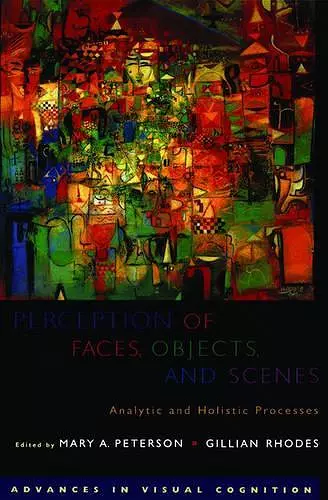Perception of Faces, Objects, and Scenes
Analytic and Holistic Processes
Gillian Rhodes editor Mary A Peterson editor
Format:Paperback
Publisher:Oxford University Press Inc
Published:22nd Jun '06
Currently unavailable, and unfortunately no date known when it will be back

From a barrage of photons, we readily and effortlessly recognize the faces of our friends, and the familiar objects and scenes around us. However, these tasks cannot be simple for our visual systems--faces are all extremely similar as visual patterns, and objects look quite different when viewed from different viewpoints. How do our visual systems solve these problems? The contributors to this volume seek to answer this question by exploring how analytic and holistic processes contribute to our perception of faces, objects, and scenes. The role of parts and wholes in perception has been studied for a century, beginning with the debate between Structuralists, who championed the role of elements, and Gestalt psychologists, who argued that the whole was different from the sum of its parts. This is the first volume to focus on the current state of the debate on parts versus wholes as it exists in the field of visual perception by bringing together the views of the leading researchers. Too frequently, researchers work in only one domain, so they are unaware of the ways in which holistic and analytic processing are defined in different areas. The contributors to this volume ask what analytic and holistic processes are like; whether they contribute differently to the perception of faces, objects, and scenes; whether different cognitive and neural mechanisms code holistic and analytic information; whether a single, universal system can be sufficient for visual-information processing, and whether our subjective experience of holistic perception might be nothing more than a compelling illusion. The result is a snapshot of the current thinking on how the processing of wholes and parts contributes to our remarkable ability to recognize faces, objects, and scenes, and an illustration of the diverse conceptions of analytic and holistic processing that currently coexist, and the variety of approaches that have been brought to bear on the issues.
This volume focuses on the current status of the debate between the Structuralist orientation, which emphasizes the role elements, and the Gestalt psychologists who argue that the whole is different from the sum of its parts. "-SciTech.
Peterson and Rhodes provide a valuable 'new look' at the classic holistic/analytic dichotomy in perceptual theory. Their selection of leading vision scientists, all focusing on perception of complex natural stimuli (faces and scenes), has resulted in a superb scholarly work that is both thought provoking and informative. * Helene Intraub, Professor of Psychology, University of Delaware *
This is a timely set of articles that address a central issue. * Stephen M. Kosslyn, Professor of Psychology, Harvard University *
The chapters are written by the leaders in the field . . . the book will become an important source text on the topic for many years. * Morris Moscovitch, Professor of Psychology, University of Toronto *
The editors have assembled a 'first string' team of writers from the fields of human face perception and human object perception . . . It's hard to imagine a more distinguished line-up of authors for these topics. * James T. Enns, Professor of Psychology, University of British Columbia *
This text is an excellent, in-depth review of current visual cognitive theory and processing modalities. It is informative and thought-provoking, helping the reader better understand how our visual system is miraculously adept at filtering a constant barrage of visual input to effortlessly recognize familiar faces, objects, and scenes. * Journal of Neuro-Ophthalmology:Volume 26 *
ISBN: 9780195313659
Dimensions: 157mm x 234mm x 18mm
Weight: 530g
406 pages